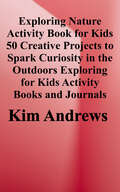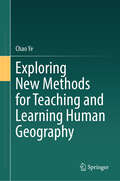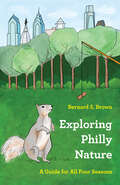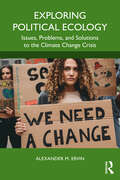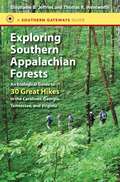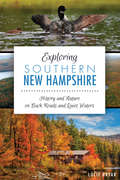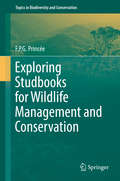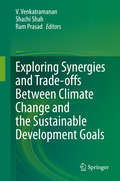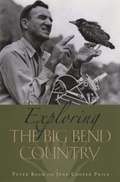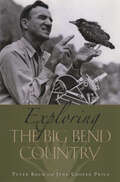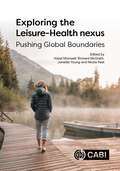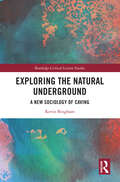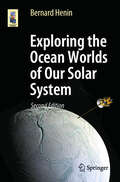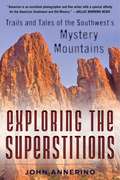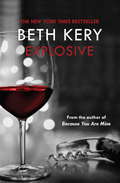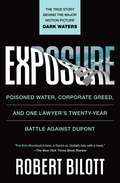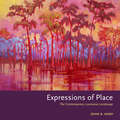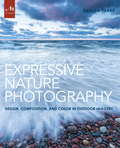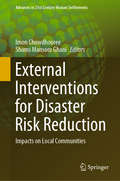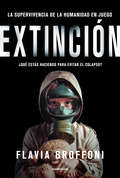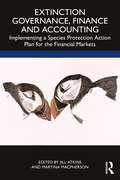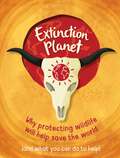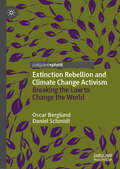- Table View
- List View
Exploring Nature Activity Book for Kids: 50 Creative Projects to Spark Curiosity in the Outdoors
by Kim AndrewsA guide to exploring the great outdoors for kids ages 6 to 12. Encourage young nature lovers to get outside and track, explore, discover, and create. This book is filled with hands-on, educational outdoor activities that kids will love to learn from, like crafting bird feeders out of fruit, pressing flowers, or creating sundials. They'll get their hands dirty and their imaginations revving while staying active outside. <p><p>This standout among nature books for kids includes: 50 Fun outdoor projects―Inspire a lifetime of curiosity with tons of guided, interactive ideas that let kids observe animals, plants, and even outer space in action. <p>Activities for everyone, everywhere―the fun and games inside cover a range of seasons and regions so all kids can start exploring, no matter where they are. <p>Important skill-building--By stopping to notice and record what's going on around them, kids will practice important skills like observation, memory, writing, drawing, wildlife safety, and more. <p><p>This hands-on approach to nature books for kids will show kids what makes the great outdoors great.
Exploring Nature in Illinois: A Field Guide to the Prairie State
by Susan Post Michael JeffordsLoaded with full color photographs and evocative descriptions, Exploring Nature in Illinois provides a panorama of the state's overlooked natural diversity. Naturalists Michael Jeffords and Susan Post explore fifty preserves, forests, restoration areas, and parks, bringing an expert view to wildlife and landscapes and looking beyond the obvious to uncover the unexpected beauty of Illinois's wild places. From the colorful variety of birds at War Bluff Valley Audubon Sanctuary to the exposed bedrock and cliff faces of Apple River Canyon, Exploring Nature in Illinois will inspire readers to explore wonders hidden from urban sprawl and cultivated farmland. Maps and descriptions help travelers access even hard-to-find sites while a wealth of detail and photography offers nature-lovers insights into the flora, fauna, and other aspects of vibrant settings and ecosystems. The authors also include diary entries describing their own impressions of and engagement with the sites. A unique and much-needed reference, Exploring Nature in Illinois will entertain and enlighten hikers, cyclers, students and scouts, morning walkers, weekend drivers, and anyone else seeking to get back to nature in the Prairie State.
Exploring New Methods for Teaching and Learning Human Geography
by Chao YeThis book proposes a new and central teaching concept "we are all makers" and innovates the geographical teaching modes and methodology. Geography teaching, especially how to teach geographical thinking, is important and related to the development of the discipline. In this field, the exploration of new teaching methods in non-English speaking countries and regions still needs to grow. Based on the author's experience of teaching geographical thinking and human (cultural) geography for more than ten years, the book links geographical thinking to the realistic cases with new social media tools such as WeChat APP and blog. Under the guidance of these new methods, such as poem, emotional, couplet game, keywords, blog-based teaching, and the like, students are transformed from passive recipients of knowledge to active learners and even creators in the end. The book, which focuses on and pioneers new teaching methodology or methods, is used as a reference by scholars, researchers, practitioners, and readers specialized in fields such as geography, education, and pedagogy.
Exploring Philly Nature: A Guide for All Four Seasons
by Bernard S. BrownDo snakes and salamanders fascinate you or make you squeamish? Have you ever listened closely to the birds chirping in your neighborhood? Can you identify the flowers growing in Philadelphia’s urban parks? (Moreover, are the mushrooms safe to eat?) Exploring Philly Nature is amateur naturalist, urban herper,* and Grid contributor Bernard Brown’s handy guide to experiencing the flora and fauna in Philly. This compact illustrated volume contains 52 activities from birding, (squirrel) fishing, and basement bug-hunting to joining a frog call survey and visiting a mussel hatchery. Brown encourages kids (as well as their parents) to connect with the natural world close to home. Each entry contains information on where and when to participate, what you will need (even if it is only patience), and tips on clubs and organizations to contact for access. The city and its environs contain a multitude of species from the lichen that grows on gravestones or trees to nocturnal animals like opossums, bats, and raccoons. Exploring Philly Nature is designed to get readers eager to discover, observe, and learn more about the concrete jungle that is Philadelphia.
Exploring Political Ecology: Issues, Problems, and Solutions to the Climate Change Crisis
by Alexander M. ErvinThis book explores some of the conditions and underlying causes of the multiple environmental crises facing humanity. Rooted in anthropology, but multidisciplinary in scope, it surveys the many socio-cultural and socio-economic errors, foibles, and follies that brought us to these circumstances. Crucially and uniquely, it outlines an array of viable and practical solutions, some of which are radically different from the current status quo and cultural expectations. The first chapter canvasses the emerging, interdisciplinary field of political ecology, then Part I examines details and trends in agriculture. Part II portrays the threats posed by carbon dependent and combustive technologies as well as the hydro and nuclear energy systems now powering the majority of human actions in developed parts of the world and expanding beyond. The third part turns to consider solutions, including green new deals, de-growth policies, localization, agroecology, alternative energy systems, and many more possibilities. The conclusions engage with urgent moral and legal issues and outline social movement strategies—all related to our collective neglect of climate change—and then finally speculate upon possible futures. This book is key reading for researchers and students interested in climate change across the social and physical sciences and humanities.
Exploring Southern Appalachian Forests
by Thomas R. Wentworth Stephanie B. JeffriesThis unique hiking guide to the southern Appalachian mountains leads readers to explore the rich forest ecosystems and other natural communities visitors encounter along the trail. Drawing on years of experience guiding forest walks throughout the region, Steph Jeffries and Tom Wentworth invite hikers and nature lovers to see their surroundings in new ways. Readers will learn to decipher clues from the tree canopies, forest floor, and other natural features to appreciate more fully the environmental factors that make the southern Appalachians home to an amazing biodiversity.These thirty popular hikes in Virginia, North Carolina, South Carolina, Tennessee, and Georgia range from short walks along Blue Ridge Parkway pull-offs to longer day trips in the region's backcountry. Offering spectacular mountain scenery and natural wildflower gardens, these trails are the perfect place to gain a new appreciation for the natural communities of the region.Features include* A summary including distance, difficulty, and GPS coordinates for each hike* A narrative description of each hike, including the unique natural features waiting to be discovered* Detailed instructions to keep you on the trail* Best seasons to go for wildflower and foliage views* Contact information for each area* Photos and maps to orient you* An illustrated guide to southern Appalachia's most common trees and shrubs, including tips on identification
Exploring Southern New Hampshire: History and Nature on Back Roads and Quiet Waters (Natural History)
by Lucie BryarWalkers, bikers, paddlers and snowshoers can encounter relics of the past and their incredible tales from Keene to the Seacoast. "Exploring Southern New Hampshire" takes history off the page, out of the car and into the welcoming pine-scented woods and pristine waters of the Granite State. Hike Mount Monadnock, paddle the Nashua River and retrace Lincoln's footsteps down Exeter's streets. Experience the legacy of a women's sawmill at Turkey Pond from the waters that powered it. Visit Cathedral of the Pines, a beautiful outdoor altar built with stones from historic sites around the world. Set sail on the Piscataqua River onboard a gundalow and learn about the region's rich maritime history. Local history explorer and nature lover Lucie Bryar leads readers through the Monadnock, Merrimack Valley and Seacoast regions. Granite State natives and transplants alike will explore trails and waterways to gain a new appreciation for the history hidden in natural New Hampshire.
Exploring Studbooks for Wildlife Management and Conservation (Topics in Biodiversity and Conservation #17)
by F.P.G. PrincéeMany endangered species of wild animals are managed in captivity through studbooks. In this book these data-rich resources are mined in innovative, integrated and statistically tested ways to maximise information gain for conservation practice – whether for captive or released/reintroduced or managed wild populations. This book is thus an important tool for all species managers, and for students and researchers in small population biology and wildlife conservation.The book's studbook analyses are grouped in three interrelated sections: natural history, demography and genetics. Statistical tests to determine the significance of results or to compare results between subgroups are undertaken throughout. Real studbooks of a variety of species, e.g. cranes, wolverines, blesbok, illustrate the practical applications and interpretations of the analyses and statistics. The “natural history” section presents analyses to determine baseline species information such as litter size, inter-birth interval, longevity and seasonality. “Demography” covers census(-style) analyses, age-class based life tables, comparative survival analyses and population projections. Solutions for dealing with small sample sizes are included.Inbreeding depression and unconscious selection form the main focus of the “genetics” section. Survival and life table analyses are used to assess inbreeding effects. Quantitative genetics methods are applied to natural history traits as a tool to monitor genetic variation. A fourth section on “conservation” shows how data from captive populations can be used where natural history data from wild populations are missing. A real example uses studbook data to inform Population Viability Analysis. The final section deals with issues related to incomplete and missing data and statistical topics.The purpose-written open-source software programs “Population Management Library (PML)” and “studbookR” used for analyses in the book, are available at www.princee.com.
Exploring Synergies and Trade-offs between Climate Change and the Sustainable Development Goals
by Ram Prasad Shachi Shah V. VenkatramananThe existential environmental crisis prompted the United Nations to formulate the Millennium Development Goals at the turn of the 21st century in order to embark on an era of sustainable development. The progress and deficiencies in achieving the Millennium Development Goals provided impetus to the intelligentsia and policymakers to map out the pertinent goals for a sustainable growth trajectory for humanity and the planet. The United Nations’ 2030 Agenda for Sustainable Development, which was adopted in September 2015, took the shape of 17 Sustainable Development Goals (SDGs) and 169 targets. In effect, the 17 Sustainable Development Goals focus on protecting the earth's life support systems for intra- and inter-generational equity and for development that is rooted in sustainability science. Attaining these goals is an uphill task; nevertheless, scientific knowledge, trans and interdisciplinary inquiries, concerted global action and capacity building would provide an enabling environment for achieving the SDGs. This book explores the synergies and trade-offs between climate change management and other SDGs. It highlights the policy imperatives as well as the interrelations between combating climate change and its impacts (SDG 13) and food and nutritional security (SDG 2), water security (SDG 6), soil security (SDG 15), energy security (SDG 7), poverty eradication (SDG 1), gender equality (SDG 5), resilient infrastructure (SDG 9), and sustainable and resilient cities (SDG 11).
Exploring Toronto: A Guide to 28 Unique Public Spaces
by Ken Greenberg Eti GreenbergA full-colour guide to dozens of unique outdoor spaces that highlight Toronto as a sustainable, liveable city.Toronto is rich in public spaces — deeply incised ravines, lively neighbourhoods, lush gardens and parks, iconic bridges, even repurposed industrial silos and undercrofts of elevated highways. Urban designer Ken Greenberg and Toronto aficionado Eti Greenberg have combed the city on foot and by tandem bike, discovering some of Toronto’s best outdoor public spaces.In Exploring Toronto, they have gathered twenty-eight of their favourite spots, each offering something unique — a flash of ingenious design, a surprise vantage point, or simply relief from the hum of traffic. Ken and Eti bring their distinctive perspective, informed by years of work in urban design, to each of their choices, providing readers (and explorers) with the full story of the history, design, and appeal of each one-of-a-kind place.
Exploring the Big Bend Country
by Price Peter Koch June CooperIn this highly readable book, Koch's daughter June Cooper Price draws on the newspaper columns her father wrote for the Alpine Avalanche, supplemented by his photographs, journal entries, and short pieces by other family members, to present Peter Koch's vision of the Big Bend.
Exploring the Big Bend Country
by Peter Koch June Cooper PricePhotographer-naturalist Peter Koch first visited the new Big Bend National Park in February, 1945, on assignment to take promotional pictures for the National Park Service. He planned to spend a couple of weeks—and ended up staying for the rest of his life. Koch’s magnificent photographs and documentary film-lectures Big Bend, Life in a Desert Wilderness and Desert Gold introduced the park to people across the United States, drawing thousands of visitors to the Big Bend. His photographs and films of the region remain among the best ever produced, and are an invaluable visual record of the first four decades of Big Bend National Park. In this highly readable book, Koch’s daughter June Cooper Price draws on the newspaper columns her father wrote for the Alpine Avalanche, supplemented by his photographs, journal entries, and short pieces by other family members, to present Peter Koch’s vision of the Big Bend. The book opens with his first “big adventure,” a six-day photographic trip through Santa Elena Canyon on a raft made from agave flower stalks. From there, Koch takes readers hiking on mountain trails and driving the scenic loop around Fort Davis. He also describes “wax smuggling” and other ways of making a living on the Mexican border; ranching in the Big Bend; the prehistory and Native Americans of the region; collaborating with botanist Barton Warnock on books of Trans-Pecos wildflowers; and the history and beauty of Presidio County, the Rio Grande, and the Chihuahuan Desert. This fascinating blend of firsthand adventures, natural history, and personal musings on anthropology and history creates an unforgettable portrait of both Peter Koch and the Big Bend region he so loved.
Exploring the Leisure - Health Nexus: Pushing Global Boundaries
by Lynn Anderson Simon Darcy Simone Grabowski Jenny Onyx Tonia Gray Katherine Dashper Torben Nielsen Joyce Simard Nina Burridge Holly Bowen-Salter Christina Davies Leila Gholizadeh Sara Karacsony Alexis Marcoux Rouleau Danielle McDonald Annette Michelsen Cour Emma Milanese Carmel Nottle Michelle O’Shea Victoria Paraschak Sonya Pearce Melanie Pescud Arianne Reis Zoei SuttonBy exploring past, current, and future intersections between leisure and health, this book considers research and academic thought to reveal and critique the nuanced ways that leisure impacts health as well as considering how health professions use leisure as a 'tool'. Aided by the diverse chapters, readers will be challenged to explore future intersections between leisure and health using an overarching eco (ecological/environmental), bio(biological), psycho (psychological), social (sociological) lens. Many of the chapters include case-studies which consider further developing leisure and health themes, particularly in relation to a number of emerging environmental, health and societal challenges that confront the world. In addition, the book: ·Is cross disciplinary and demonstrates non-individualized framing of health (as per the WHO definition) giving readers a unique opportunity to develop an understanding of sociological frameworks, including ecobiopyschosocial, salutogenic, multi-species and criticalist. ·Moves readers from an individual level understanding of interconnections between leisure and health through to a consideration of global issues (including a section on the impact and consequences of Covid-19). ·Examines the nexus between leisure and health through a focus on a number of population groups including First Nations peoples, women, incarcerated people, migrants, people with disabilities, older people, and the human-animal interface. The book will be of significant interest to researchers/academics/practitioners in the leisure, health, sport, tourism, recreation, events, social science, and arts disciplines.
Exploring the Natural Underground: A New Sociology of Caving (Routledge Critical Leisure Studies)
by Kevin BinghamThis book explores the enigmatic world of the natural underground, viewing it as a site of leisure and a primary sphere of anthropotechnics. It reshapes the old language of caving into new ideas that broaden the possibilities of the sociology of caving. After outlining a novel methodological approach that can be used to understand new leisure trends and cultures in present modernity, Exploring the Natural Underground offers a comprehensive investigation of the societal context in which caving takes place. Thereafter, it goes on to argue that the natural underground can be used as a means of escaping some of the unavoidable influences of consumer capitalism in the way that it stimulates imaginations, senses and emotions differently. Marking a turning point in the way that the natural underground is understood and the degree to which sensory dimensions of leisure are valued, this book will appeal to anybody interested in caving, as well as scholars and students of leisure studies, the sociology of leisure, the ethnography of leisure and human geography.
Exploring the Ocean Worlds of Our Solar System (Astronomers' Universe)
by Bernard HeninIn the past 25 years, planetary science has undergone a revolution with the discovery of vast oceans of liquid water within the icy moons of our Solar System. These subsurface oceans are concealed beneath thick ice layers. We refer to these moons and similar ocean-bearing planetary objects as ocean worlds. In this 2nd edition, we delve into and compare the latest scientific discoveries on 22 confirmed or potential ocean worlds, ranging from the giant asteroid Ceres and the icy moons Europa and Enceladus to the distant dwarf planets of the outer Solar System such as Pluto, Sedna, and Eris. Along the way, we explore the contributions of multiple spacecraft, such as the Pioneers, the Voyagers, Galileo, Cassini-Huygens, and many others, which have provided much of our current knowledge about these worlds, as well as the latest scientific research on this subject. This book also explores the potential for life on each of the confirmed ocean worlds evaluating their habitability. Ultimately, these might hold the key to answering fundamental questions about life: How did life begin? Is there life beyond Earth? Where do we come from? With contributions from leading planetary scientists at NASA, ESA, and other institutions, this book aims to be the definitive reference for anyone interested in this captivating subject.
Exploring the Superstitions: Trails and Tales of the Southwest's Mystery Mountains
by John AnnerinoArizona’s Superstition Mountains are like no other mountain range in the continental United States. The ancestral ground of the western Apache and sacred heights of the neighboring Pima, these mountains were once a veritable no-man’s land of soaring cliffs, dead-end box canyons, and eerie hoodoos of stone, marking them as one of the last places on earth that any person would dare to tread. While this range appears on the surface to be a veritable nature lover’s paradise with towering saguaro cactus forests, desert wildflowers, and roadrunners, it is also home to rattlesnakes, plants and animals that stick, sting, or bite, and modern gun-toting, dry-gulchers. In fact, in the last century, the Superstition Mountains have claimed the lives of more than 500 visitors, marking it as the West’s deadliest wild area. Part hiking guide, part history book, Superstitions: Hiking the Ghost Trails of Mystery Mountain vividly brings the supernatural beauty, mystery, and majesty of this unique area to life. Within the pages of Superstitions, readers will first be swept up in the legends of the Superstition Mountains, encountering colorful historical characters such as 1840s gold prospectors, brave-hearted Apaches, and sly outlaws. Readers will encounter the native flora and fauna of the range, from poisonous rattlesnakes to rare flowers. And finally, an in-depth guide to every trail in the range, will satisfy even the most experienced of hikers. Including a foldout map and dozens of original photos, Superstitions belongs on the shelf, or in the backpack, of every history buff and every veteran hiker.
Explosive
by Beth KeryFor fans for Sylvia Day, J. Kenner and Maya Banks. An emotionally gripping tale of erotic romance suspense from the New York Times ebook bestselling author of the Because You Are Mine series and The Affair.Dr. Sophie Gable wasn't expecting her peaceful getaway to be shattered by the arrival of a half-dazed, dead-sexy guest. Thomas Nicasio has obviously been traumatized, and Sophie thinks she knows by what. There's something about Thomas's father that he can't - or won't - remember. Something that could get them both killed. Still she can't resist Thomas's electrifying seduction - or her instincts to help him... An ex-Navy explosives specialist, Thomas has never felt this type of volatile need for a woman. Even while he's grieving the deaths of his brother and nephew, something in Sophie makes Thomas want to overtake her, and each time he does, her willing submission makes him want her all the more. But danger is lurking close by, and if he can't face the demons of his past, he and Sophie could be the next victims in a pattern of meaningless violence...Enter the seductive world of Beth Kery where the rules are broken with that first electrifying touch in the sizzling Because You Are Mine, One Night of Passion and The Affair novels.
Exposure: Poisoned Water, Corporate Greed, and One Lawyer's Twenty-Year Battle against DuPont
by Robert Bilott&“For Erin Brockovich fans, a David vs. Goliath tale with a twist&” (The New York Times Book Review)—the incredible true story of the lawyer who spent two decades building a case against DuPont for its use of the hazardous chemical PFOA, uncovering the worst case of environmental contamination in history—affecting virtually every person on the planet—and the conspiracy that kept it a secret for sixty years. The story that inspired Dark Waters, the major motion picture from Focus Features starring Mark Ruffalo and Anne Hathaway, directed by Todd Haynes.1998: Rob Bilott is a young lawyer specializing in helping big corporations stay on the right side of environmental laws and regulations. Then he gets a phone call from a West Virginia farmer named Earl Tennant, who is convinced the creek on his property is being poisoned by runoff from a neighboring DuPont landfill, causing his cattle and the surrounding wildlife to die in hideous ways. Earl hasn&’t even been able to get a water sample tested by any state or federal regulatory agency or find a local lawyer willing to take the case. As soon as they hear the name DuPont—the area&’s largest employer—they shut him down. Once Rob sees the thick, foamy water that bubbles into the creek, the gruesome effects it seems to have on livestock, and the disturbing frequency of cancer and other health problems in the area, he&’s persuaded to fight against the type of corporation his firm routinely represents. After intense legal wrangling, Rob ultimately gains access to hundreds of thousands of pages of DuPont documents, some of them fifty years old, that reveal the company has been holding onto decades of studies proving the harmful effects of a chemical called PFOA, used in making Teflon. PFOA is often called a &“forever chemical,&” because once in the environment, it does not break down or degrade for millions of years, contaminating the planet forever. The case of one farmer soon spawns a class action suit on behalf of seventy thousand residents—and the shocking realization that virtually every person on the planet has been exposed to PFOA and carries the chemical in his or her blood. What emerges is a riveting legal drama &“in the grand tradition of Jonathan Harr&’s A Civil Action&” (Booklist, starred review) about malice and manipulation, the failings of environmental regulation; and one lawyer&’s twenty-year struggle to expose the truth about this previously unknown—and still unregulated—chemical that we all have inside us.
Expressions of Place: The Contemporary Louisiana Landscape
by John R. KempExpressions of Place embarks on a journey across the rural and urban landscapes of Louisiana via the talents of thirty-seven artists located all around the state. Many are acclaimed professionals whose paintings are included in major private and public collections regionally and nationally. Others have found their followings closer to home. All, however, strive to express impressions of the land with artistic styles that range from traditional to the symbolic and almost totally abstract. Such a variety of interpretation becomes possible in a landscape that changes from dark cypress-shrouded bayous, trembling earth, grassy prairies, the gritty streets of inner city New Orleans to vast wind-swept coastal marshes and the piney hills of north and central Louisiana. Rather than stand as an encyclopedia, catalog, or history of the visual arts in Louisiana, Kemp's book is instead a celebration of the state's evocative landscape in the work of accomplished contemporary artists. It includes an introductory essay, which places these creators and their works in historical context. Expressions of Place provides readers with individual essays and biographical sketches in which the artists, in their own words, give insight as to what they paint, how they paint, where they paint, and why they are drawn to the Louisiana landscape. Particularly inspiring, the artists discuss their interpretations of that landscape directly with the viewing audience. Expressions of Place remains as much about the landscape of the artists' imaginations as it is about the land itself. With each painting, they have created visual poetry of a land and environment that has become a defining part of their lives.
Expressive Nature Photography: Design, Composition, and Color in Outdoor Imagery
by Brenda TharpPhotographer and teacher Brenda Tharp marries photography craft with artistic vision to help intermediate photographers translate what they see into a personal impression of a subject in nature. Using single images, along with before-and-after and with-or-without examples, Expressive Nature Photography teaches how to make exposures that are creative, not necessarily correct. Inspiring photographers to get out early and stay out late, this book explains how to use light, an essential element of outdoor photography. Readers will learn how to “see in the dark,” use filters to create very long exposures, create a natural effect using light painting, photograph night skies and moonlit landscapes, and make the best use of available natural light. This book also covers how to use shutter speeds to express motion and capture the energy of fast-moving subjects, such rushing streams, ocean swells, and bounding wildlife. A chapter on the art of visual flow discusses how to create compositions that direct the viewer's eye through the frame for maximum impact. Photographers will develop a sense of when to break the "rules" of composition, how to use elements to frame subjects, what to include and exclude in the frame, how to create the feeling of depth and dimension in a scene, and how to push the boundaries of composition to make memorable nature images that capture and convey fresh viewpoints. High-tech cameras can help create a good exposure and focused image, but they can't replace the artist's eye for composition, visual depth, and design, nor their instinct for knowing when to click the shutter. There are many books on photography technique focused on technical quality, but Expressive Nature Photography goes beyond the technical. It guides the way to pulling emotion and meaning out of a dynamic landscape, a delicate macro study, or an outstanding nighttime image.
External Interventions for Disaster Risk Reduction: Impacts on Local Communities (Advances in 21st Century Human Settlements)
by Imon Chowdhooree Shams Mansoor GhaniThis book presents a case study-based analysis of the consequences of external interventions, critically evaluating them from community perspectives. Communities – from rural to urban, and around the world – that are experiencing disasters and changes in climatic variables can perceive the associated risks and evaluate the impacts of interventions. Accordingly, community perspectives, including their perceptions, concerns, awareness, realizations, reactions and expectations, represent a valuable resource. The case-based analysis of impacts on communities can provide a ‘means of learning’ from the experiences of others, thus expanding professionals’ knowledge base, especially regarding disaster mitigation and climate change adaptation practices in varied settings. This book offers valuable insights and lessons learned, in an effort to promote and guide innovative changes in the current planning, management and governance of human settlements, helping them face the future challenges of a changing environment.
Extinción: La supervivencia de la humanidad en juego. / ¿Qué estás haciendo para evitar el colapso?
by Flavia BroffoniLa información sobre la crisis ecológica y climática está al alcance de todos y en boca de nadie. Extinción nos revela toda la información que no sale en los medios hegemónicos de comunicación, y pone en evidencia la crisis planetaria en que nos encontramos. Este es un libro urgente para entender qué hay detrás de esta crisis. Desde las estrategias políticas, el agronegocio y los modelos educativos hasta las formas de consumo que nos parecen naturales, este libro cuenta con la fuerza suficiente para hacernos ver la realidad y comenzar a actuar conscientemente. Extinción nos revela con evidencia científica la crisis ecológica y climática que atraviesa nuestro planeta. En los próximos cincuenta años 4000 millones de personas vivirán en zonas no aptas para la producción de alimentos. Para 2080 América del Sur estará en una sequía extrema. El 60% de los mamíferos y el 70% de las aves son criados para alimentar humanos. Este año una pandemia puso en estado de emergencia a todo el mundo. El 60% de las enfermedades infecciosas son transmitidas por animales. Mientras, crece la población de animales industrializados en hábitats naturales destruidos y ecosistemas alterados. ¿Qué estamos haciendo para frenar este ecocidio? ¿Por qué esta información no está al alcance de todos? Flavia Broffoni propone darle batalla a la civilización que está arrasando con la naturaleza. Extinción es un libro urgente: quedan menos de diez años para detener el colapso. En palabras de la autora, "la decisión más honesta que podemos tomar en estos momentos de incertidumbre es qué hacer con el Tiempo que tenemos".
Extinction Governance, Finance and Accounting: Implementing a Species Protection Action Plan for the Financial Markets
by Jill AtkinsThe planet is currently experiencing a mass extinction event, with human and business activity being the root cause of species loss and habitat destruction. Industries, companies, banks, investors, accountants and auditors have all played their role. This book explores how they can also provide a solution. The book presents plans, metrics, frameworks, mechanisms and financial innovations that can be, and are being, implemented through the financial markets in order to save and protect species, enhance biodiversity and, at the same time, preserve the financial markets and the business world. This biodiversity handbook addresses the intersection between species extinction and the global capitalist system. With contributions from leading non-governmental organisations such as the Capitals Coalition, Business for Nature, the Ecojustice Foundation, ShareAction and the Endangered Wildlife Trust, plus senior researchers in the field, as well as industry experts from Moody’s, EOS at Hermes Federated Investment Management, BlueBay Asset Management, ODDO BHF Asset Management and OSSIAM (to mention just a few), this book is at the forefront of addressing the crucially important topics of extinction accounting, finance and governance. Drawing on leading research, the book is written in an accessible style and is relevant to researchers and students in the fields of sustainability, governance, accounting, finance, corporate social responsibility and corporate governance. It is essential reading for investors, responsible investors, bankers, business leaders and policy makers in the field of sustainable financial markets. Given the interdisciplinary nature of this book, it is useful to conservationists, ecologists and others involved in species and biodiversity protection.
Extinction Planet
by Anna ClaybourneExtinction Planet offers young readers a clear, insightful look at Earth's wildlife extinction crisisIt is estimated that out of around eight million species on Earth, at least one million plant and animal species are threatened with extinction, and that the current rate of extinction is up to 100 times higher than in any previous mass extinction. And it's human activity that's largely responsible for this frightening decline.Extinction Planet takes a non-alarmist, but truthful, look at Earth's extinction crisis, explaining what a mass extinction is, how they occur and what their repercussions can be. It explores how, as humankind has caused this latest biodiversity crisis, we also have the solutions to slow or stop its damage, from reining in overconsumption, rewilding natural places, making farming more planet-friendly, preventing overfishing and seriously tackling climate change. It also suggests ways we can all live in a more planet-friendly way, from global changes such as investing in renewable energy sources, to individual actions such as buying sustainable products and eating less meat and fish.Following on from Plastic Planet, Hot Planet, Recycled Planet and Sustainable Planet, Extinction Planet features the same blend of illustrations and photos and a striking cover, and is written by the award-winning author Anna Claybourne.Aimed at readers aged 9 and up.
Extinction Rebellion and Climate Change Activism: Breaking the Law to Change the World
by Daniel Schmidt Oscar BerglundThis book summarises and critiques Extinction Rebellion (XR) as a social movement organisation, engaging with key issues surrounding its analysis, strategy and tactics. The authors suggest that XR have an underdeveloped and apolitical view of the kind of change necessary to address climate change, and that while this enables the building of broad movements, it is also an obstacle to achieving the systemic change that they are aiming for. The book analyses different forms of protest and the role of civil disobedience in their respective success or failure; democratic demands and practices; and activist engagement with the political economy of climate change. It engages with a range of theoretical perspectives that address law-breaking in protest and participatory forms of democracy including liberal political theory; anarchism and forms of historical materialism, and will be of interest to students and scholars across politics, international relations, sociology, policy studies and geography, as well as those interested in climate change politics and activism.
